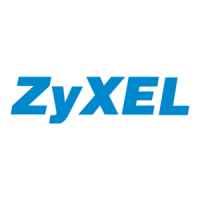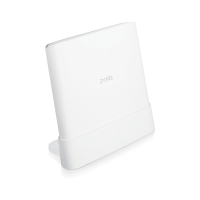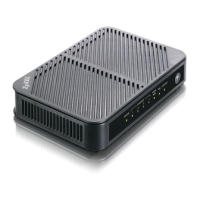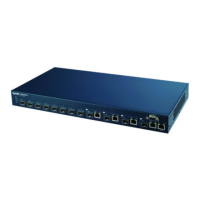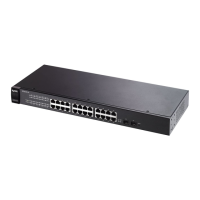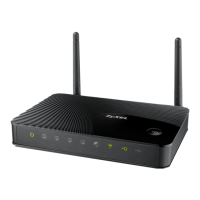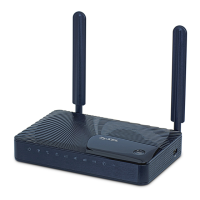Chapter 8 Broadband
AX/DX/EX/PX Series User’s Guide
230
The following table describes the labels in this screen.
Table 52 Network Setting > Broadband > Advanced
LABEL DESCRIPTION
DSL Capabilities
PhyR US Enable or disable PhyR US (upstream) for upstream transmission to the WAN. PhyR US should be
enabled if data being transmitted upstream is sensitive to noise. However, enabling PhyR US can
decrease the US line rate. Enabling or disabling PhyR will require the CPE to retrain. For PhyR to
function, the DSLAM must also support PhyR and have it enabled.
PhyR DS Enable or disable PhyR DS (downstream) for downstream transmission from the WAN. PhyR DS
should be enabled if data being transmitted downstream is sensitive to noise. However,
enabling PhyR DS can decrease the DS line rate. Enabling or disabling PhyR will require the CPE
to retrain. For PhyR to function, the DSLAM must also support PhyR and have it enabled.
PhyR US/DS Enable or disable PhyR US/DS (upstream/downstream) for both upstream and downstream
transmission to the WAN. PhyR US should be enabled if data being transmitted upstream is
sensitive to noise. However, enabling PhyR US can decrease the US line rate. Enabling or
disabling PhyR will require the CPE to retrain. For PhyR to function, the DSLAM must also support
PhyR and have it enabled.
Bitswap Select Enable to allow the Zyxel Device to adapt to line changes when you are using G.dmt.
Bit-swapping is a way of keeping the line more stable by constantly monitoring and redistributing
bits between channels.
SRA Enable or disable Seamless Rate Adaption (SRA). Select Enable to have the Zyxel Device
automatically adjust the connection’s data rate according to line conditions without
interrupting service.
DSL Modulation
PTM over ADSL Select Enable to use PTM over ADSL. Since PTM has less overhead than ATM, some ISPs use this for
better performance.
G.Dmt ITU G.992.1 (better known as G.dmt) is an ITU standard for ADSL using discrete multitone
modulation. G.dmt full-rate ADSL expands the usable bandwidth of existing copper telephone
lines, delivering high-speed data communications at rates up to 8 Mbit/s downstream and 1.3
Mbit/s upstream.
G.lite ITU G.992.2 (better known as G.lite) is an ITU standard for ADSL using discrete multitone
modulation. G.lite does not strictly require the use of DSL filters, but like all variants of ADSL
generally functions better with splitters.
T1.413 ANSI T1.413 is a technical standard that defines the requirements for the single asymmetric
digital subscriber line (ADSL) for the interface between the telecommunications network and
the customer installation in terms of their interaction and electrical characteristics.
ADSL2 It optionally extends the capability of basic ADSL in data rates to 12 Mbit/s downstream and,
depending on Annex version, up to 3.5 Mbit/s upstream (with a mandatory capability of ADSL2
transceivers of 8 Mbit/s downstream and 800 kbit/s upstream).
Annex L Annex L is an optional specification in the ITU-T ADSL2 recommendation G.992.3 titled Specific
requirements for a Reach Extended ADSL2 (READSL2) system operating in the frequency band
above POTS, therefore it is often referred to as Reach Extended ADSL2 or READSL2.The main
difference between this specification and commonly deployed Annex A is the maximum
distance that can be used. The power of the lower frequencies used for transmitting data is
boosted up to increase the reach of this signal up to 7 kilometers (23,000 ft).
ADSL2+ ADSL2+ extends the capability of basic ADSL by doubling the number of downstream channels.
The data rates can be as high as 24 Mbit/s downstream and up to 1.4 Mbit/s upstream
depending on the distance from the DSLAM to the customer's premises.
Annex M Annex M is an optional specification in ITU-T recommendations G.992.3 (ADSL2) and G.992.5
(ADSL2+), also referred to as ADSL2 M and ADSL2+ M. This specification extends the capability of
commonly deployed Annex A by more than doubling the number of upstream bits. The data
rates can be as high as 12 or 24 Mbit/s downstream and 3 Mbit/s upstream depending on the
distance from the DSLAM to the customer's premises.
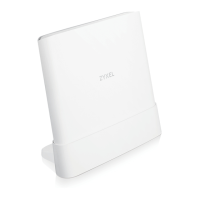
